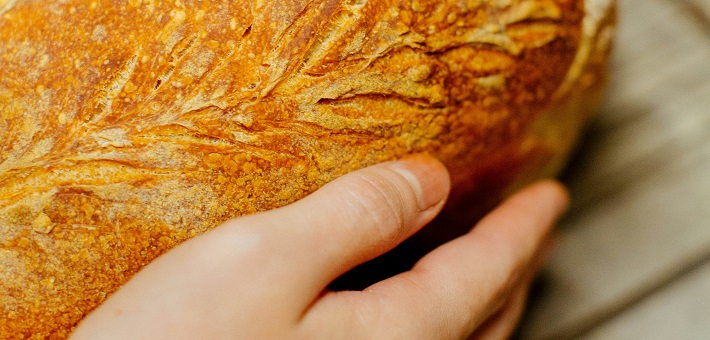Commentary on John 6:1-21
The opening of John 6 includes Jesus’ miraculous provision of food and his crossing the Sea of Galilee that divinely transports his disciples to the other side. These events form the foundation for Jesus’ Bread of Life discourse in the later part of the chapter (6:25–58). In John 6:1–21, Jesus both feeds the crowd and tests his disciples as he reveals himself, and God, to them. Rather than accepting the crowd’s shortsighted confession, or forsaking his overconfident disciples, Jesus challenges those who follow to know him as the “I am” and, in so doing, to let go of their desire to control him.
Our passage can be divided into three shorter portions. John 6:1–4 provides the setting and introduces the main characters; 6:5–15 describes the feeding miracle and its immediate aftermath; 6:16–21 narrates the disciples’ departure across the sea and Jesus’ later joining them with his revelatory “I am” upon the water.
In verses 1–4 we learn that Jesus is sitting upon a mountain with his disciples near the Sea of Galilee shoreline. Even though Passover “is near,” Jesus does not seem in any rush to hurry back to Jerusalem after his last encounter in John 5. At the same time, Jesus is continuing his work from John 5, where he first cured a man who was stuck next to the Pool of Bethsaida for 38 years because of his “illness” or “weakness” (astheneia; 5:5). In John 6:3, we learn that Jesus is still curing the “weak” or “sick ones” (tōn asthenoutōn) brought to him.
Jesus’ “signs” (sēmeia) are a common occurrence in Galilee (2:11, 18, 23; 4:48, 54), and while their revelation is profound, people often need further divine assistance to get the whole picture of Jesus’ identity (see also 2:23–25; 4:43–48; 9:40–41).
With all these people gathered around him, Jesus sets in motion the events of John 6:5–15 with a question directed at Philip but meant for all the disciples gathered with him. Philip was among the first disciples to follow Jesus, having been “found” and called by Jesus in 1:43–44. In fact, Philip is from the same hometown as Andrew and Simon Peter, who will also have speaking roles later in John 6. Instead of commanding Philip as in 1:43, Jesus now questions him: “Where shall we buy loaves so that these ones might eat?” (6:5, my translation). Interestingly, Jesus doesn’t ask if the people should be fed but, rather, how they can be fed.
Even as Philip ponders (or panics!), the narrator tells us Jesus is not just asking Philip; he’s testing (peirazōn) him. Jesus, it turns out, “already knew what he was about to do” (6:6). This testing element often makes us uncomfortable because it seems more like the devil’s domain from Jesus’ time in the wilderness from the Synoptic tradition (see Matthew 4:1; Mark 1:13; Luke 4:2). In John’s Gospel, however, Jesus routinely challenges those who have confessed faith in him; he is constantly pushing to see just how sincere or robust that faith is (for example, 6:22–71; 8:31–59; 13:36–38).
Jesus ultimately feeds the crowd with five loaves and two fish that Andrew brings him, leaving enough surplus that his disciples must gather the leftovers in 12 baskets (6:11–13). Jesus’ choice to have the disciples themselves collect the remainder is powerful; he is demonstrating to them that he can provide more than enough. The crowd, it seems, is convinced—at least of something. They try to make Jesus “king,” but he retreats, leaving his disciples for a time and allowing them to make another choice: do they wait or try to cross the sea without him?
Arguably, Jesus’ retreat from the crowd and from his disciples continues the test begun in 6:5. And once again, the disciples’ response is problematic—they leave behind the one they profess to follow! In 6:16–17 the narrator tells us they “went down to the sea, got into a boat, and started across the sea to Capernaum. It was now dark, and Jesus had not yet come to them” (New Revised Standard Version). These disciples have left the “true Light” (1:9) and are now upon the waters of chaos in darkness. Even as the sea begins to churn because of a “strong wind” (anemou megalou), they continue rowing out into the depths. They do not even seem to understand their precarious situation.
Only when they see Jesus walking toward them upon the water do they become “terrified” (6:19). Rather than condemning them for their fear, however, Jesus calms them with a phrase: “I am; don’t fear anymore.” My translation highlights the revelatory nature of Jesus’ words. This isn’t a simple statement; it is a claim of divine presence. When we picture the scene, we join the disciples in seeing this epiphany, or theophany—an appearance of God in their midst.
The disciples react much like the crowd in 6:14; they, too, want to claim Jesus for themselves by placing him in their boat. Seemingly during this action, however, the boat slides upon the sandbar, arriving on the other side of the lake. Long before his death and resurrection, Jesus appears suddenly, and he resists the claims others place upon him (see 20:11–31).
In John 6:1–21 we are also tested. We learn that Jesus provides more than we can anticipate and that he does not submit to our small definitions. When we take the surplus loaves and rush out ahead of Jesus, we can quickly find ourselves overwhelmed on dark and stormy seas. Jesus, though, does not abandon us. Instead, he joins us and reveals himself to us, providing a way forward that we cannot explain. Rather than claiming Jesus as one we can control and keep in our boats, then, we recognize that John’s Jesus reveals himself to be so much more. He beckons us to wait for fuller revelation and to hold fast to his hour instead of pushing our agendas upon him.
Be sure to check out the blog article by Kendall Vanderslice on Preaching the Bread of Life series from John 6.


July 28, 2024